Sir John Monash, Personal Files Book 12, 2 May - 31 May 1916, Part 1
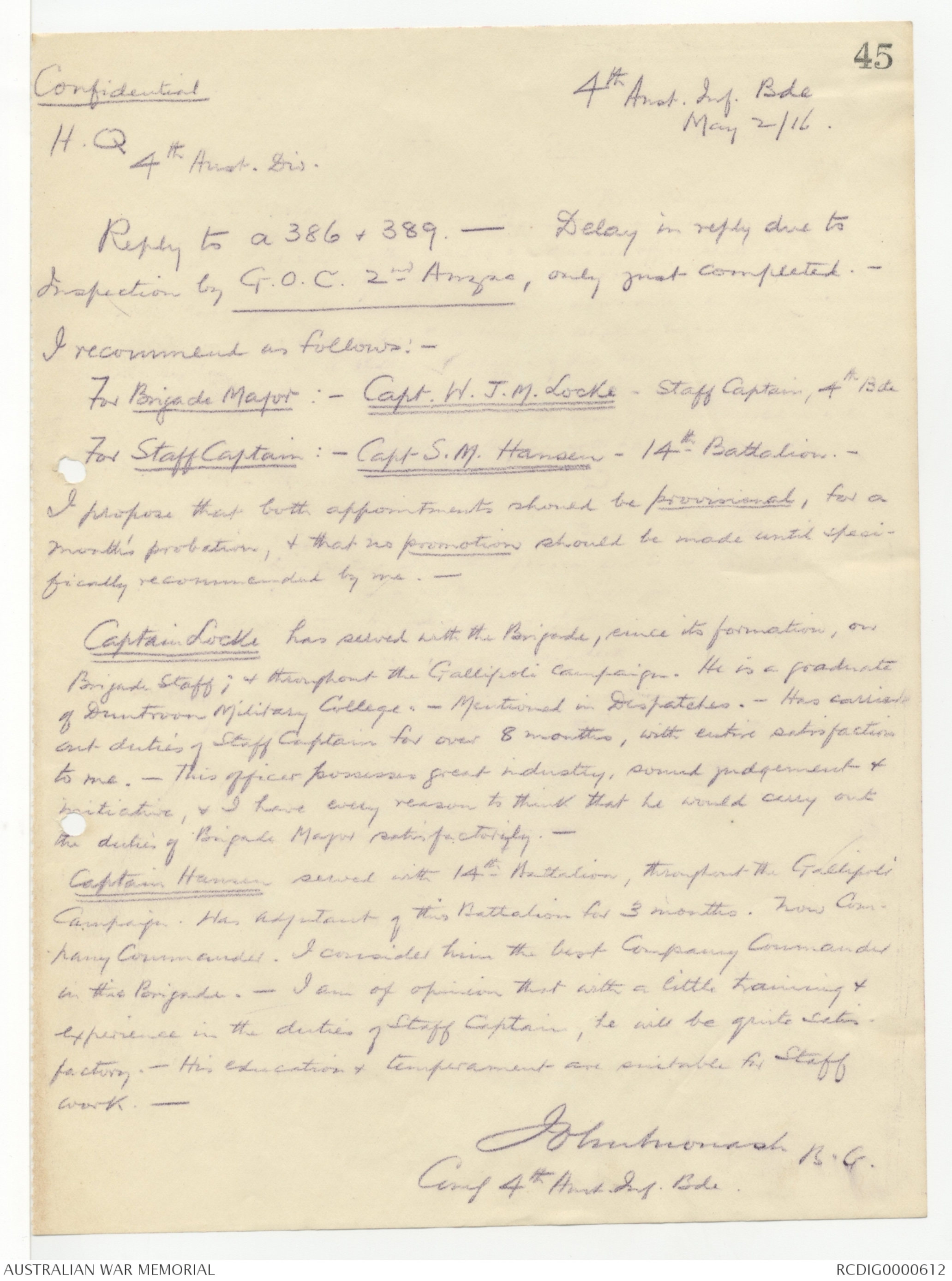
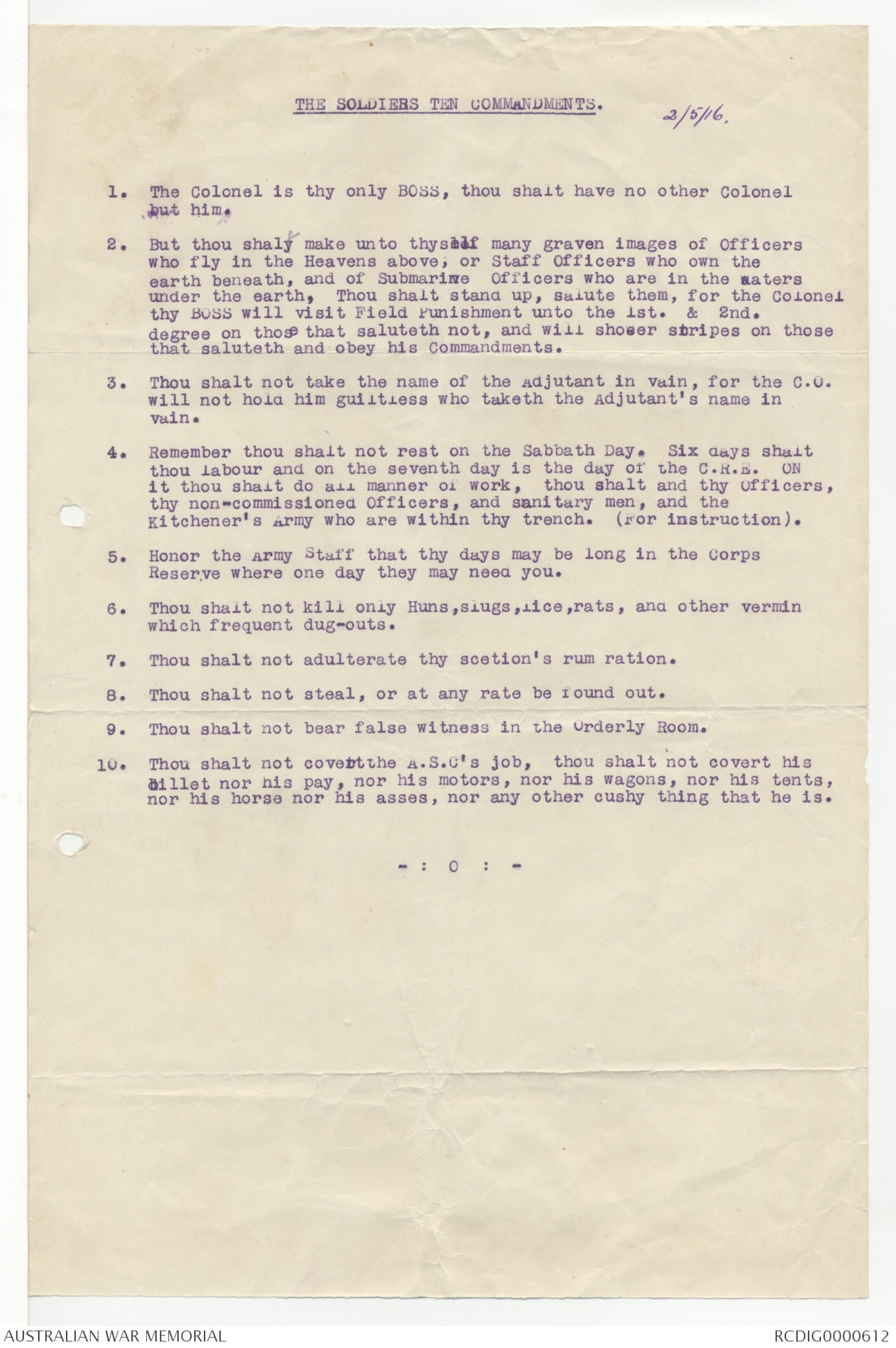
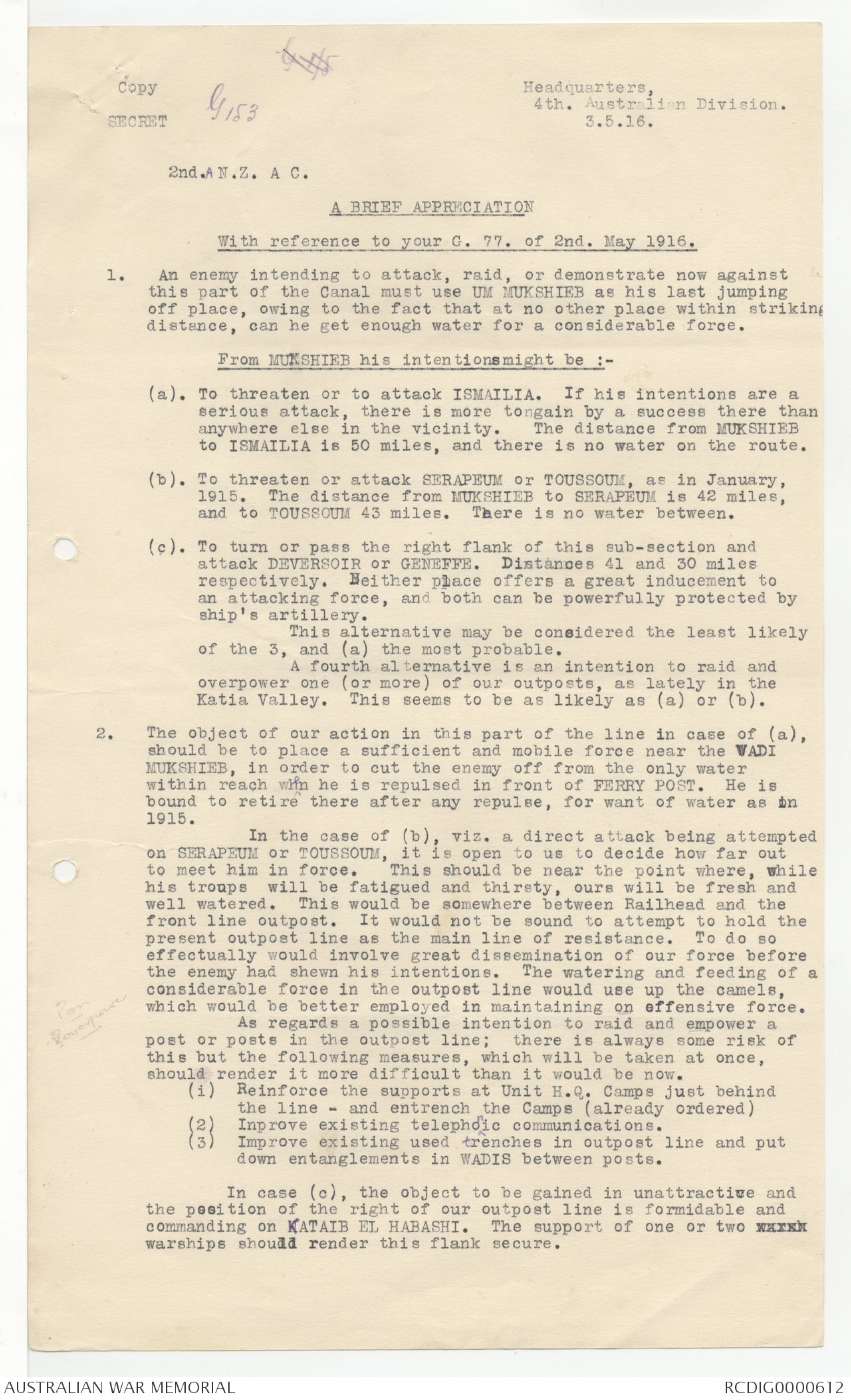
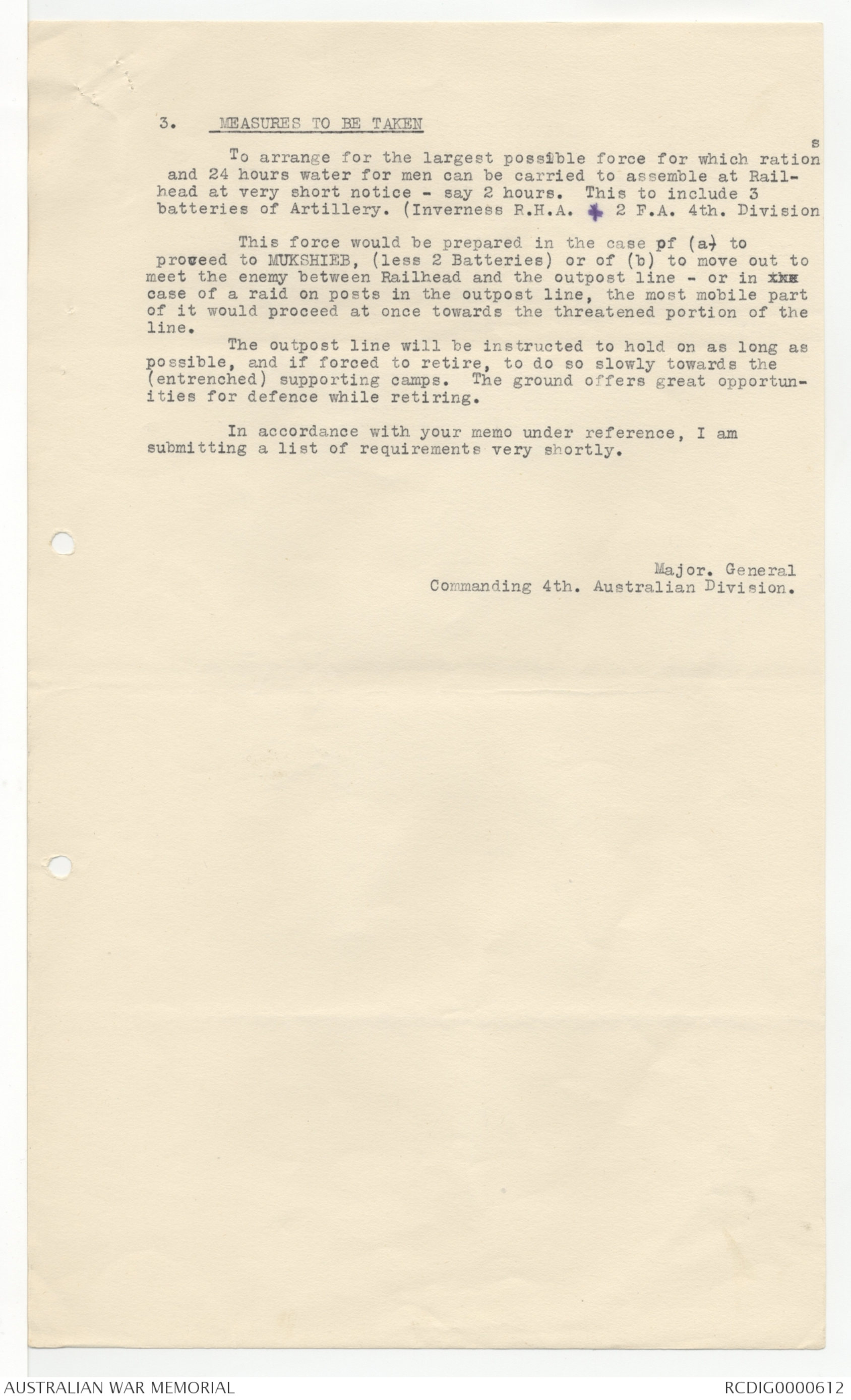
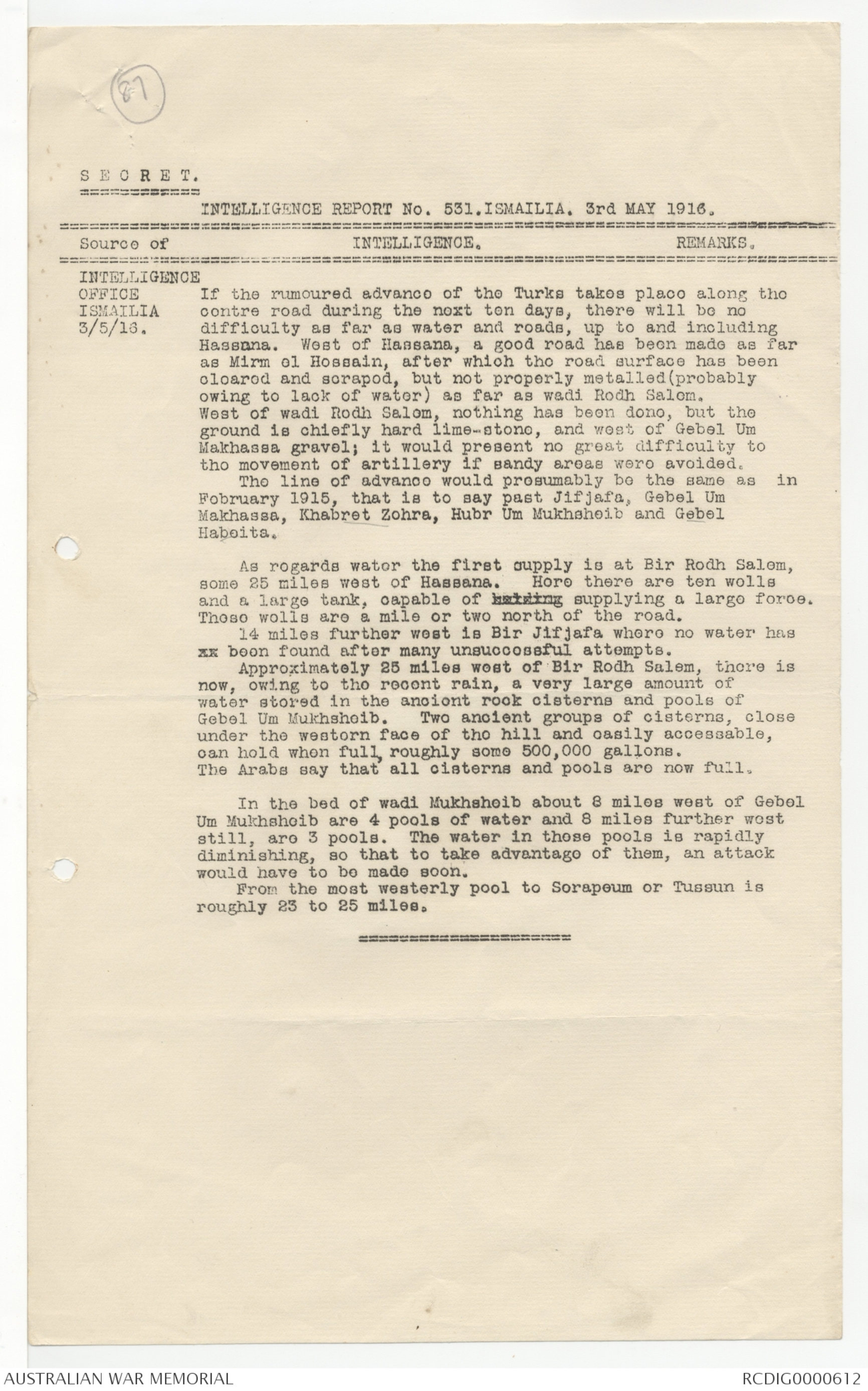
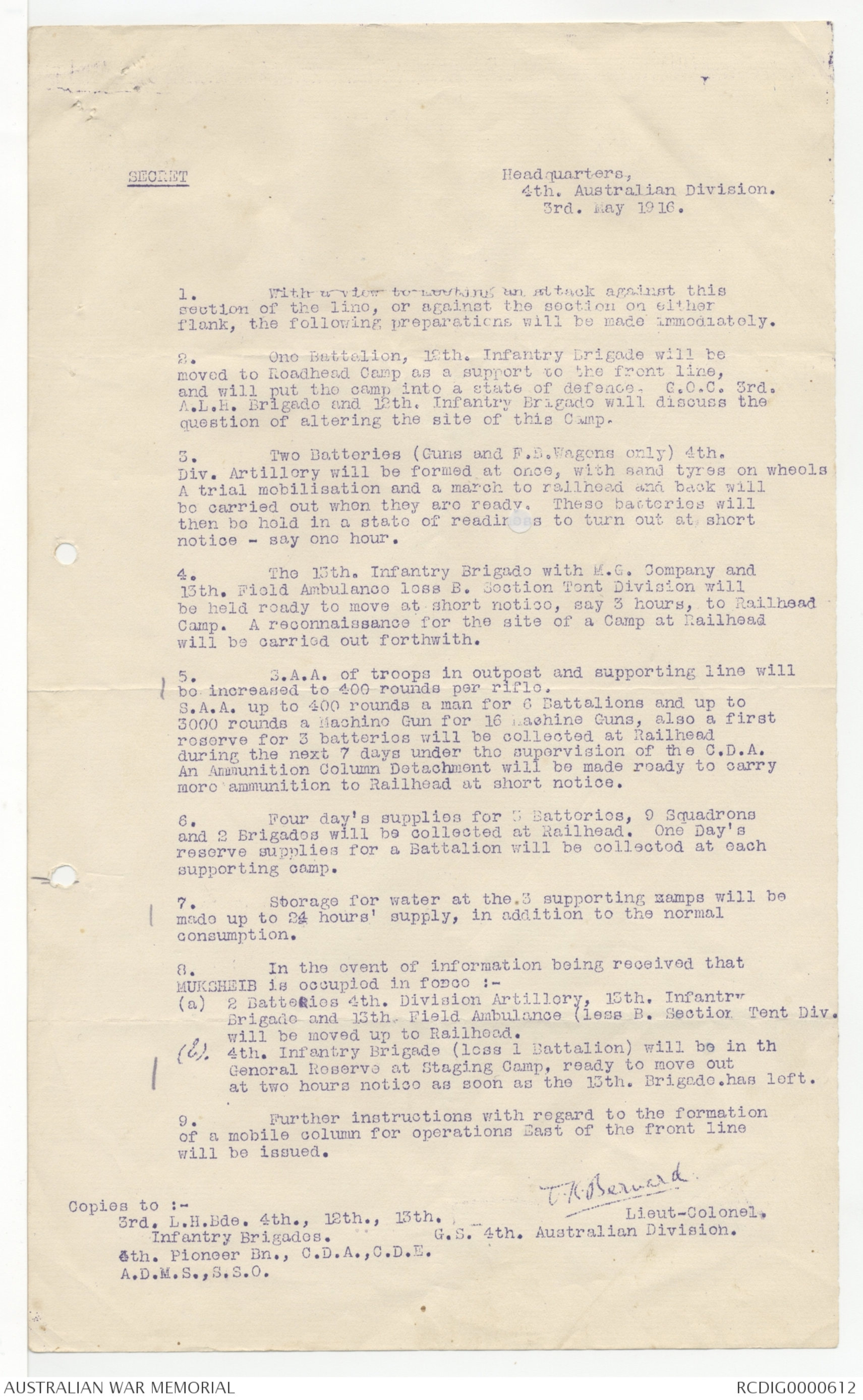
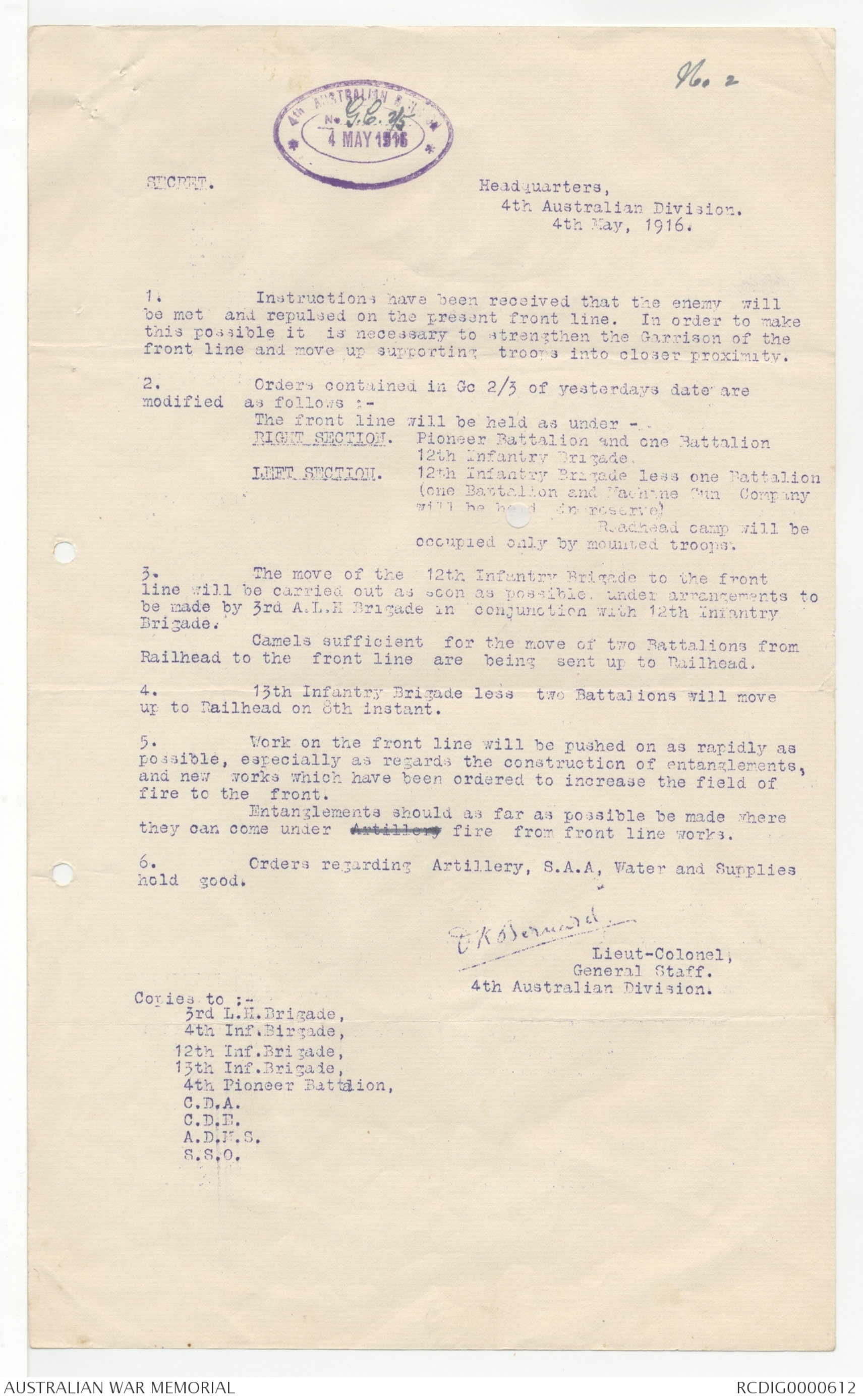
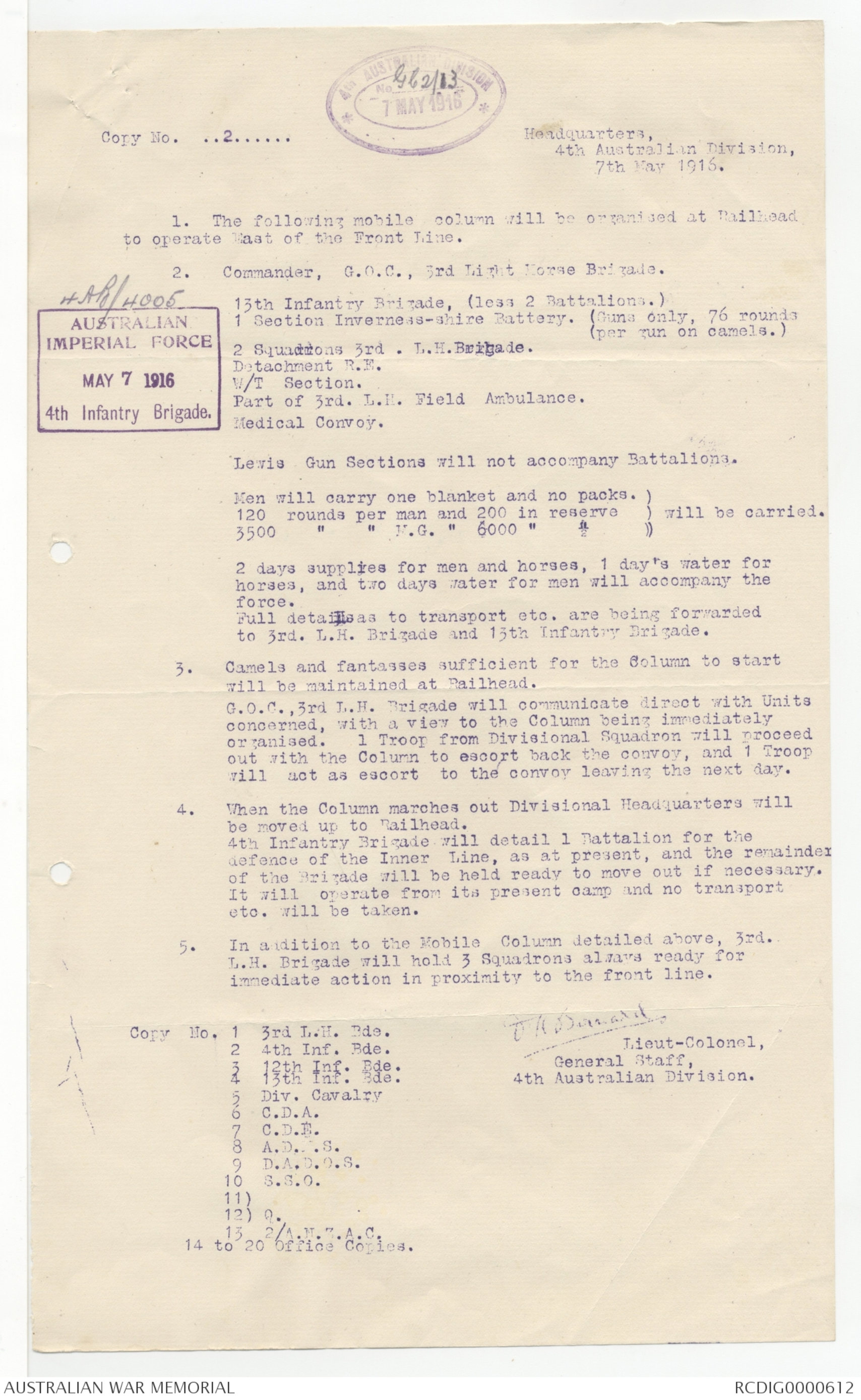
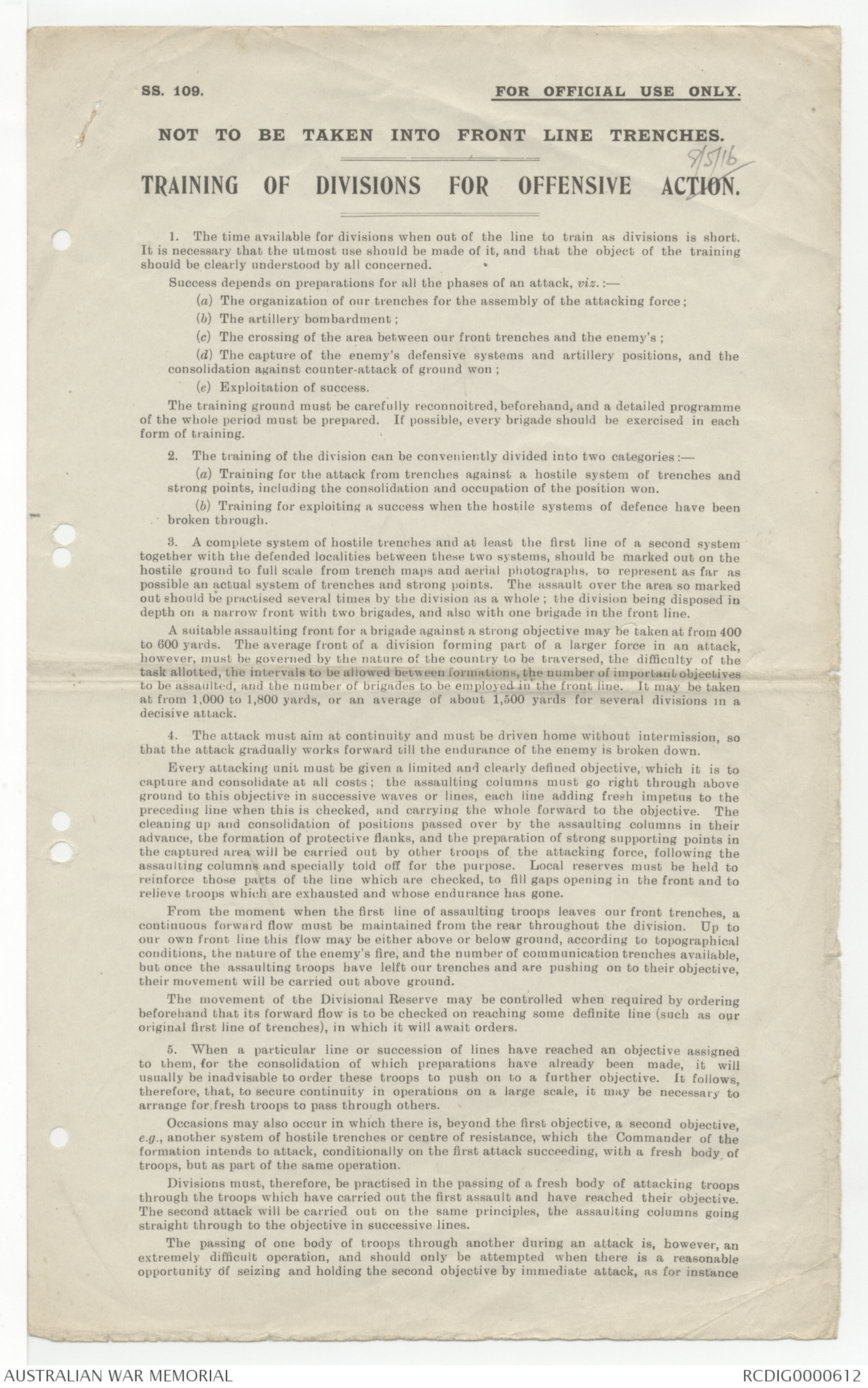
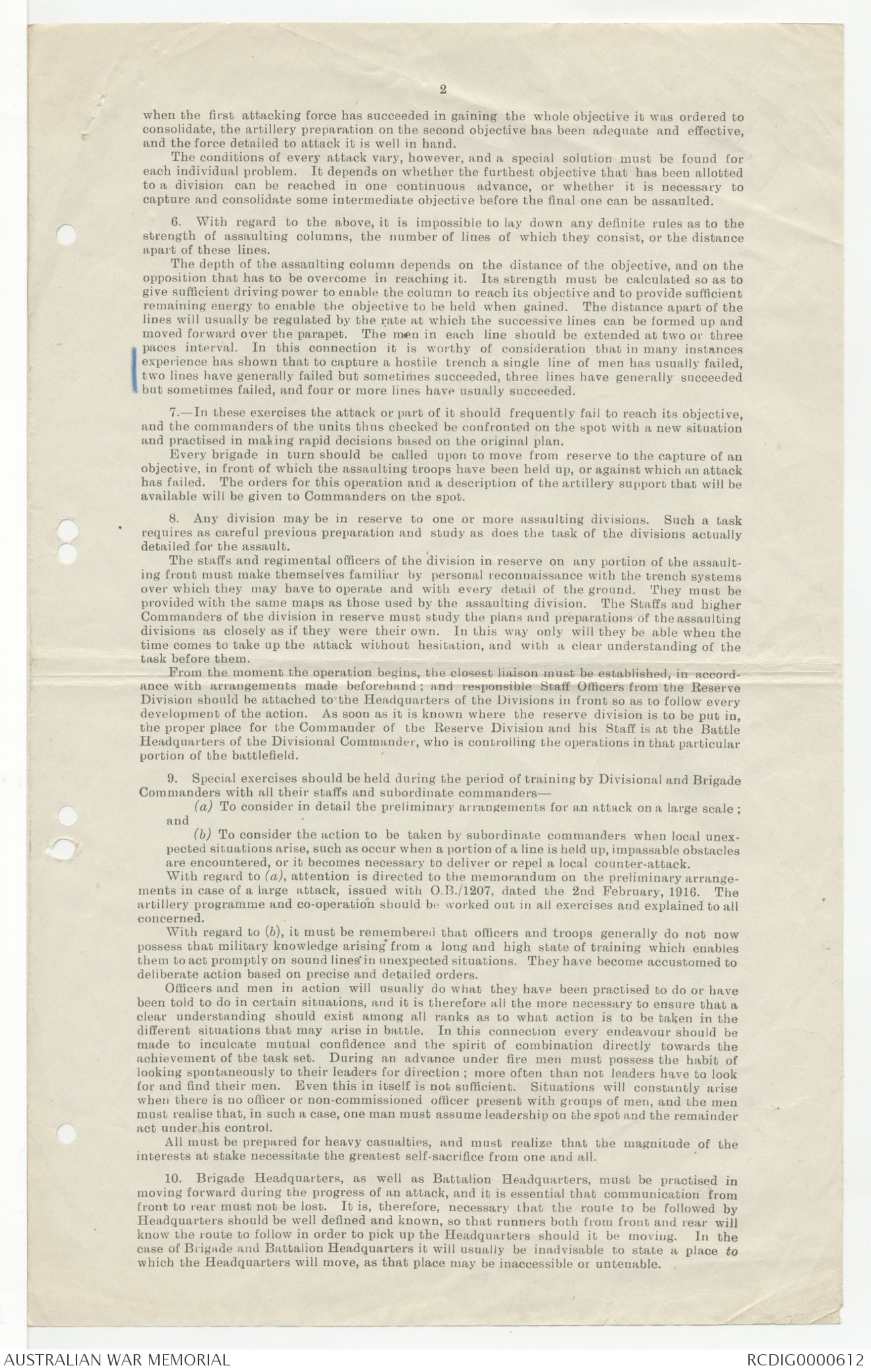
45
Confidential
4th Aust. Inf. Bde
May 2/16
H.Q
4th Aust. Div.
Reporting to a 386 & 389. - Delay in reply due to
Inspection by G.O.C. 2nd Anzac, only just completed. -
I recommend as follows: -
For Brigade Major: - Capt. W. J. M Locke - Staff Captain, 4th Bde
For Staff Captain: - Capt. S. M. Hansen - 14th Battalion. -
I propose that both appointments should be provisional, for a
month's probation, & that no promotion should be made until specifically
recommended by me. -
Captain Locke has served with the Brigade, since its formation, on
Brigade Staff; & throughout the Gallipoli Campaign. He is a graduate
of Duntroon Military College. - Mentioned in Dispatches. - Has carried
out duties of Staff Captain for over 8 months, with entire satisfaction
to me. - This officer possesses great industry, sound judgement &
initiative, & I have every reason to think that he would carry out
the duties of Brigade Major satisfactorily. -
Captain Hansen served in with 14th Battalion, throughout the Gallipoli
Campaign. Was adjutant of this Battalion for 3 months. Now Company
Commander. I consider him the best Company Commander
in this Brigade. - I am of opinion that with a little training &
experience in the duties of Staff Captain, he will be quite satisfactory. -
His education & temperament are suitable for Staff
work.
John Monash B.G.
Comg 4th Aust. Inf. Bde.
THE SOLDIERS TEN COMMANDMENTS.
2/5/16
1. The Colonel is the only BOSS, thou shalt have no other Colonel
but him
2. But thou shalyt make unto thyself many graven images of Officers
who fly in the Heavens above, or Staff Officers who own the
earth beneath, and of Submarine Officers who are in the waters
under the earth, Thou shalt stand up, salute them, for the Colonel
thy BOSS will visit Field Punishment unto the 1st. & 2nd.
degree on those that saluteth not, and will shower stripes on those
that saluteth and obey his Commandments.
3. Thou shalt not take the name of the Adjutant in vain, for the C.O.
will not hold him guiltless who taketh the Adjutant's name in vain.
4. Remember thou shalt not rest on the Sabbath Day. Six days shalt
thou labour and on the seventh day is the day of the C.R.E. ON
it thou shalt do all manner of work, thou shalt and thy Officers,
thy non-commissioned Officers, and sanitary men, and the
Kitchener's Army who are within thy trench. (For instruction).
5. Honor the Army Staff that thy days may be long in the Corps
Reserve where one day they may need you.
6. Thou shalt not kill only Huns, slugs, lice, rats and other vermin
which frequent dug-outs.
7. Thou shalt not adulterate thy section's rum ration.
8. Thou shalt not steal, or at any rate be found out.
9. Thou shalt not bear false witness in the Orderly Room.
10. Thou shalt not covert the A.S.C's job, thou shalt covert
his billet nor his pay, nor his motors, nor his wagons, nor his tents,
nor his horse nor his asses, nor any other cushy thing that he is.
-:0:-
[*G 1/5*]
Copy
SECRET
[*G153*]
Headquarters,
4th. Australian Division.
3.5.16.
2nd. AN.Z.AC.
A BRIEF APPRECIATION
With reference to your G. 77. of 2nd. May 1916.
1. An enemy intending to attack, raid, or demonstrate now against
this part of the Canal must use UM MUKSHIEB as his last jumping
off place, owing to the fact that at no other place within striking
distance, can he get enough water for a considerable force.
From MUKSHIEB his intentions might be:-
(a). To threaten or to attack ISMAILIA. If his intentions are a
serious attack, there is more tongain by a success there than
anywhere else in the vicinity. The distance from MUKSHIEB
to ISMAILIA is 50 miles, and tehere is no water on the route.
(b). To threaten or attack SERAPEUM or TOUSSOUM, as in January,
1915. The distance from MUKSHIEB to SERAPEM is 42 miles,
and to TOUSSOUM 43 miles. There is no water between.
(c). To turn or pass the right flank of this sub-section and
attack DEVERSOIR or GENEFFE. Diniststannces 41 and 30 miles
respectively. bNeither pplace offers a great inducement to
an attacking force, and both can be powerfully protected by
ship's artillery.
This alternative may be conasidered the least likely
of the 3, and (a) the most probable.
A fourth alternative is an intention to raid and
overpower one (or more) of our outposts, as lately in the
Katia Valley. This seems to be as likely as (a) or (b).
2. The object of our action in this part of the line in case of (a),
should be to place a sufficient and mobile force near the VWADI
MUKSHIEB, in order to cut the enemy off from the only water
within reach when he is repulsed in front of FERRY POST. He is
bound to retire there after any repulse, for want of water as in
1915.
In the case of (b), viz. a direct attack being attempted
on SERAPEUM or TOUSSOUM, it is open to us to decide how far out
to meet him in force. This should be near the point where, ewhile
his troops will be fatigued and thirsty, ours will be fresh and
well watered. This would be somewhere between Railhead and the
front line outpost. It would not be sound to attempt to hold the
present outpost line as the main line of resistance. To do so
effectually would involve great dissemination of our force before
the enemy had shewn his intentions. The watering and feeding of a
considerable force in the outpost line would use up the camels,
which would be better employed in maintaining on eoffensive force.
[*PanBVourpoure*]
As regards a possible intention to raid and empower a
post or posts in the outpost line; there is always some risk of
this but the following measures, which will be taken at once,
should render it more difficult than it would be now.
(1) Reinforce the supports at Unit H.Q. Camps just behind
the line - and entrench the Camps (already ordered)
(2) Improve existing telepho^nic communications.
(3) Improve existing used trenches in outpost line and put
down entanglements in WADIS between posts.
In case (c), the object to be gained in unattractive and
the position of the right of our outpost line is formidable and
commanding on HKATAIB EL HABASHI. The support of one or two warsh
warships shoudlld render this flank secure.
3. MEASURES TO BE TAKEN
To arrange for the largest possible force for which ration^s
and 24 hours water for men can be carried to assemble at Railhead
at very short notice - say 2 hours. This to include 3
batteries of Artillery. (Inverness R.H.A. & 2 F.A, 4th Division
This force would be prepared in the case of (a) to
provceed to MUKSHIRE, (less 2 Batteries) or of (b) to move out to
meet the enemy between Railhead and the outpost line - or in the
case of a raid on posts in the outpost line, the most mobile part
of it would proceed at once towards the threatened portion of the
line.
The outpost line will be instructed to hold on as long as
possible, and if forced to retire, to do so slowly towards the
(entrenched) supporting camps. The ground offers great opportunities
for defence while retiring.
In accordance with your memo under reference I am
submitting a list of requirements very shortly.
Major. General
Commanding 4th. Australian Division.
87
SECRET
INTELLIGENCE REPORT No. 531. ISMAILIA. 3rd MAY 1916
Source of INTELLIGENCE. REMARKS.
INTELLIGENCE OFFICE ISMAILIA 3/5/16.
If the rumoured advance of the Turks takes place along the
centre road during the next ten days, there will be no
difficulty as far as water and roads, up to and including
Hassnana. West of Hassana., a good road has been made as far
as Mirm el Hossain, after which the road surface has been
cleared and scrapod, but not properly metalled (probably
owing to lack of water) as far as wadi Rodh Salom.
West of wadi Rodh Salom, nothing has been dono, but the
ground is chiefly hard lime-stone, and west of Gebel Um
Makhassa gravel; it would present no great difficulty to
the movement of artillery if sandy areas were avoided.
The line of advance would presumably be the same as in
February 1915, that is to say past Jifjafa, Gebel Um
Makhassa, Khabret Zohra, Hubr Um Mukhshieb and Gebel
Haboita.
As regards water the first supply is at Bir Rodh Salem.
some 25 miles west of Hassana. Here there are ten wells
and a large tank, capable of holding supplying a large force.
Those wells are a mile or two north of the road.
14 miles further west is Bir Jifjafa where no water hasne been found after many unsuccessful attempts.
Approximately 25 miles west of Bir Rodh Salem, there is
now, owing to the recent rain, a very large amount of
water stored in the ancient rock cisterns and pools of
Gebel Um Mukhsheib. Two ancients groups of cisterns, close
under the western face of the hill and easily accessible,
can hold when full, roughly some 500,000 gallons.
The Arabs say that all cisterns and pools are now full.
In the bed of wadi Mukhsheib about 8 miles west of Gebel
Um Mukhsheib are 4 pools of water and 8 miles further west
still, are 3 pools. The water in those pools is rapidly
diminishing, so that to take an advantage of them, an attack
would have to be made soon.
From the most westerly pool to Serapeum to Tussun is
roughly 23 to 25 miles.
SECRET
Headquarters,
4th. Australian Division.
3rd. May 1916.
1. With a view to meeting an attack against this
section of the line, or against the section on either
flank, the following preparations will be made immediately.
2. One Battalion, 12th. Infantry Brigade will be
moved to Roadhead Camp as support to the front line,
and will put the camp into a state of defence. G.O.C. 3rd.
A.L.H. Brigade and 12th. Infantry Brigade will discuss the
question of altering the site of this Camp.
3. Two Batteries (Guns and F.S. Wagons only) 4th.
Div. Artillery will be formed at once, with sand tyres on wheels
A trial mobilisation and a march to railhead and back will
be carried out when they are ready. These batteries will
then be held in a state of readiness to turn out at short
notice - say one hour.
4. The 13th. Infantry Brigade with M.G. Company and
13th. Field Ambulance less B. Section Tent Division will
be held ready to move at short notice, say 3 hours, to Railhead
Camp. A reconnaissance for the site of a Camp at Railhead
will be carried out forthwith
[*|*] 5. S.A.A. of troops in outpost and supporting line will
be increased to 400 rounds per rifle.
S.A.A. up to 400 rounds a man for 6 Battalions and up to
3000 rounds a Machine Gun for 16 Machine Guns, also a first
reserve for 3 batteries will be collected at Railhead
during the next 7 days under the supervision of the C.D.A.
An Ammunition Column Detachment will be made ready to carry
more ammunition to Railhead at short notice.
6. Four day's supplies for 5 Batteries, 9 Squadrons
and 2 Brigades will be collected at Railhead. One Day's
reserve supplies for a Battalion will be collected at each
supporting camp.
[*|*] 7. Storage for water at the.3 supporting zcamps will be
made up to 24 hours' supply, in addition to the normal
consumption.
8. In the event of information being received that
MUKSHEIB is occupied in force;-
(a) 2 Batteeries 4th. Division Artillery, 13th. Infantry
Brigade and 13th. Field Ambulance (less B. Section Tent Div.
will be moved up to Railhead.
[*|*] (b) 4th. Infantry Brigade (less 1 Battalion) will be in th
General Reserve at Staging Camp, ready to move out
at two hours notice as soon as 13th. Brigade.has left.
9. Further instructions with regard to the formation
of a mobile column for operations East of the front line
will be issued.
D. K. Bernard
Lieut- Colonel,
G.S.4th. Australian Division.
Copies to:-
3rd. L.H.Bde. 4th., 12th., 13th.
Infantry Brigades.64th. Pioneer Bn., C.D.A., C.D.E.
A.D.M.S., S.S.O.
No 2
4th AUSTRALIAN DIVISION
No G.C. 2/5
4 MAY 1916
SECRET.
Headquarters,
4th Australian Division.
4th May, 1916.
1. Instructions have been received that the enemy will
be met and repulsed on the present front line. In order to make
this possible it is necessary to strengthen the Garrison of the
front line and move up supporting troops into closer proximity.
2. Orders contained in Gc 2/3 of yesterdays date are
modified as follows:-
The front line will be held as under-
RIGHT SECTION. Pioneer Battalion and one Battalion
12th Infantry Brigade
LEFT SECTION. 12thh Infantry Brigade less one Battalion
(one Battalion and Machine Gun Company
will be held in reserve)
Railhead camp will be
occupied only by mounted troops.
3. The move of the 12th. Infantry Brigade to the front
line will be carried out as soon as possible under arrangements to
be made by 3rd. A.L.H. Brigade in conjunction with 12th Infantry
Brigade.
Camels sufficient for the move of two Battalions from
Railhead to the front line are being sent up to Railhead.
5. Work on the front line will be pushed on as rapidly as
possible, especially as regards the construction of entanglements,
and new works which have been ordered to increase the field of
fire to the front.
Entanglements should as far as possible be made where
they can come under Artillery fire from front line works.
6. Orders regrading Artillery, S.A.A, Water and Supplies
hold good.
D K Bernard
Lieut- Colonel,
General Staff.
4th Australian Division.
Copies to:-
3rd L.H. Brigade,
4th Inf Brigade,
12th Inf Brigade,
13th Inf Brigade,
4th Pioneer Battalion,
C.D.A.
C.D.E.
A.D.M.S.
S.S.O.
4th AUSTRALIAN DIVISION
No G.C. 2/13
4 MAY 1916
Copy No. 2
Headquarters,
4th Australian Division.
7th May, 1916.
1. The following mobile column will be organised at Railhead
to operate East of Front Line.
2. Commander, G.O.C., 3rd Light Horse Brigade.
13th Infantry Brigade, (less 2 Battalions.)
1 Section Inverness-shire Battery (Guns only, 76 rounds
(per gun on camels.)
2 Squalddrons 3rd. L.H. Beggrigade.
Detachment R.E.
W/T Section.
Part of 3rd. L.H. Field Ambulance.
Medical Convoy.
[*4AB/4005
AUSTRALIAN
IMPERIAL FORCE
MAY 7 1916
4th Infantry Brigade*]
Lewis Gun Sections will not accompany Battalions.
Men will carry 1 blanket and no packs. )
120 rounds per man and 200 in reserve ) will be carried.
3500 " " M.G. " 6000 " ½" ))
2 days supplies for men and horses, 1 days water for
horses, and two days water for men will accompany the
force.
Full detaiyils as to transport etc. are being forwarded
to 3rd. L.H. Brigade and 13th Infantry Brigade.
3. Camels and fanatasses sufficient for the Column to start
will be maintained at Railhead.
G.O.C., 3rd L.H. Brigade will communicate direct with Units
concerned, with a view to the column being immediately
organised. 1 Troop from Divisional Squadron will proceed
out with the Column to escort back the convoy, and 1 Troop
will act as escort to the convoy leaving the next day.
4. When the Column marches out Divisional Headquarters will
be moved up to Railhead.
4th Infantry Brigade will detail 1 Battalion for the
defence of the Inner Line, as at present, and the Remainder
of the Brigade will be held ready to move out if necessary.
It will operate from its present camp and no transport
etc. will be taken.
5. In addition to the Mobile Column detailed above, 3rd.
L.H. Brigade will hold 3 Squadrons always ready for
immediate action in proximity to the front line.
D K Bernard
Lieut- Colonel,
General Staff,
4th. Australian Division.
Copy No. 1 3rd L.H. Bde.
2 4th Inf Bde.
3 12th Inf Bde.
4 13th Inf Bde.
5 Div. Calvary
6 C.D.A.
7 C.D.E.
8 A.D.M.S.
9 D.A.D.O.S.
10 S.S.O.
11)
12) Q.
13 2/A.N.Z.A.C
14 to 20 Office Copies.
FOR OFFICIAL USE ONLY.
NOT TO BE TAKEN INTO FRONT LINE TRENCHES.
TRAINING OF DIVISIONS FOR OFFENSIVE ACTION.
8/5/1916
1. The time available for divisions when out of line to train as divisions is short.
It is necessary that utmost use should be made of it, and that the object of the training
should be clearly understood by all concerned.
Success depends on preparations for all classes of attack, viz:-
(a) The organisation of our trenches for the assembly of the attacking force;
(b) The Artillery bombardment;
(c) The crossing of the area between our front trenches and the enemy's;
(d) The capture of the enemy's defensive systems and artillery positions, and the
consolidation against counter-attack of ground won;
(e) Exploitation of success.
The training ground must be carefully reconnoitered, beforehand, and a detailed programme
of the whole period must be prepared. If possible, every brigade should be exercised in each
form of training.
2. The Training of the division can be conveniently divided into two categories;-
(a) Training for the attack from trenches against a hostile system of trenches and
strong points, including the consolidation and occupation of the position won.
(b) Training for exploiting a success when the hostile systems of defence have been
broken through.
3. A complete system of hostile trenches and at least the first line of a second system
together with the defended localities between these two systems, should be marked out on the
hostile ground to full scale from trench maps and aerial photographs, to represent as far as
possible an actual system of trenches and strong points. The assault over the are so marked
out should be practised several times by the division as a whole; the division being disposed in
depth on a narrow front with two brigades, and also with one brigade in the front line.
A suitable assaulting front for a brigade against a strong objective may be taken at from 400
to 600 yards. The average front for a division forming part of a larger force in an attack,
however, must be governed by the nature of the country to be traversed, the difficulty of the
task allocated, the intervals to be allowed between formations, the number of important objectives
to be assaulted, the number of brigades to be employed in the front line. It may be taken
at from 1,000 to 1.800 yards, or an average of about 1,500 yards for several divisions in a
decisive attack.
4. The attack must aim at continuity and must be driven home without intermission, so
that the attack gradually works forward till the endurance of the enemy is broken down.
Every attacking unit must be given a limited and clearly defined objective, which it is to
capture and consolidate at all costs; the assaulting columns must go right through above
ground to this objective in successive waves or lines, each line adding fresh impetus to the
preceding line when this is checked, and carrying the whole forward to the objective. The
cleaning up and consolidation of positions passed over by the assaulting columns in their
advance, the formation of protective flanks, and the preparation of strong supporting points in
the captured area will be carried out by other troops of the attacking force, following the
assaulting columns and specially told off for the purpose. Local reserves must be held to
reinforce those parts of the line which are checked, to fill gaps opening in the front and to
relieve troops which are exhausted and whose endurance has gone.
From the moment when the first line of assaulting troops leaves our front trenches, a
continuous forward flow must be maintained from the rear throughout the division. Up to
our own front line this flow may either be above or below ground, according to the topographical
conditions, the nature of the enemy's fire, and the number of communication trenches available,
but once the assaulting troops have lelfth out trenches and are pushing on to their objective,
their movement will be carried out above ground.
The movement of the Divisional Reserve may be controlled when required by ordering
beforehand that its forward flow is to be checked on reaching some definite line (such as our
original first line of trenches), in which it will await orders.
5. When a particular line or succession of lines have reached an objective assigned
to them, for the consolidation of which preparations have already been made, it will
usually be inadvisable to order these troops to push onto a further objective. It follows,
therefore, that, to secure continuity in operations on a large scale, it may be necessary to
arrange for fresh troop to pass through orders.
Occasions may also occur in which there is, beyond the first objective, a second objective,
e.g., another system of hostile trenches or centre of resistance, which the Commander of the
formation intends to attack, conditionally on the first attack succeeding, with a fresh body of
troops, but as part of the same operation.
Divisions must, therefore, be practised in the passing of a fresh body of attacking troops
through the troops which have carried out the first assault and have reached their objective.
The second attack will be carried out on the same principles. the assaulting columns going
straight through to the objective in successive lines.
The passing of one body of troops through another during an attack is, however, an
extremely difficult operation, and should only be attempted when there is a reasonable
opportunity of seizing and holding the second objective by immediate attack, as for instance
2
when the first attacking force has succeeded in gaining the whole objective it was ordered to
consolidate, the artillery preparation on the second objective has been adequate and effective,
and the force detailed to attack it is well in hand.
The conditions of every attack vary, however, and a special solution must be found for
each individual problem. It depends on whether the furthest objective that has been allotted
to a division can be reached in one continuous advance, or whether it is necessary to
capture and consolidate some intermediate objective before the final one can be assaulted.
6. With regard to the above, it is impossible to lay down any definite rules as to the
strength of assaulting columns, the number of lines of which they consist, or the distance
apart of these lines.
The depth of the assaulting column depends on the distance of the objective, and on the
opposition that has to be overcome in reaching it. Its strength must be calculated so as to
give sufficient driving power to enable the column to reach its objective and to provide sufficient
remaining energy to enable the objective to be held when gained. The distance apart of the
lines will usually be regulated by the rate at which the successive lines can be formed up and
moved forward over the parapet. The men in each line should be extended at two or three
paces interval. In this connection it is worthy of consideration that in many instances
[*|
|
|*]
experience has shown that to capture a hostile trench a single line of men has usually failed,
two lines generally failed but sometimes succeeded, three lines have generally have succeeded
but sometimes failed, and four or more lines have usually succeeded.
7. In these exercises the attack or part of it should frequently fail to reach its objective,
and commanders of the units thus checked be confronted on the spot with a new situation
and practised in making rapid decisions based on the original plan.
Every brigade in turn should be called upon to move from reserve to the capture if an
objective, in front of which the assaulting troops have been held up, or against which an attack
has failed. the orders for this operation and a description of the artillery support that will be
available will be given to Commanders on the spot.
8, Any division may be in reserve to one or more assaulting divisions. Such a task
requires as careful previous preparation and study as does the task of the divisions actually
detailed for the assault.
The staffs and regimental officers of the division in reserve on any portion of the assaulting
front must make themselves familiar by personal reconnaissance with the trench systems
over which they may have to operate and with every detail on the ground. They must be
provided with the same maps as those used by the assaulting division. The Staffs and higher
Commanders of the division in reserve must study the plans and preparations of the assaulting
divisions as closely as if they were their own. In this way only will they be able when the
time comes to take up the attack without hesitation, and with clear understanding of the
task before them.
From the moment the operation begins, the closest liaison must be established, in accordance
with arrangements made beforehand; and responsible Staff Officers from the Reserve
Division should be attached to the Headquarters of the Divisions in front so as to follow every
development of the action. As soon as it is known where the reserve division is to be put in,
the proper place for the Commander of the Reserve Division and his staff is at the Battle
Headquarters of the Divisional Commander, who is controlling the operations in that particular
portion of the battlefield.
9. Special exercises should be held during the period of training by Divisional and Brigade
Commanders with their staffs and subordinate commanders-
(a) To consider in detail the preliminary arrangements for an attack on a large scale;
and
(b) To consider the action to be taken by subordinate commanders when local unexpected
situations arise, such as occur when a portion of a line is held up, impassible obstacles
are encountered, or as it becomes necessary to deliver or repel a counter-attack.
With regard to (a), attention is directed to memorandum on the preliminary arrangements
in case of large attack, issued with O.B./1207, dated the 2nd February 1916. The
artillery programme and co-operation should be worked out in all exercises and explained to all
concerned.
With regard to (b), it must be remembered that officers and troops generally do not now
possess that military knowledge arising from a long and high state of training which enables
them to act promptly on sound lines in unexpected situations. They have become accustomed to
deliberate action based on precise and detailed orders.
Officers and men in action will usually do what they have been practised to do or have
been told to do in certain situations, and it is therefore all the more necessary to ensure that a
clear understanding should exist among all ranks as to what action is to be taken in the
different situations that may arise in battle. In this connection every endeavour should be
made to inculcate mutual confidence and the spirit of combination directly towards the
achievement of the task set. During an advance under fire men must possess thee habit of
looking spontaneously to their leaders for direction; more often than not leaders have to look
for and find their men. Evern this in itself is not sufficient. Situations constantly arise
when there is no officer or non-commissioned officer present, with groups of men, and the men
must realise that, in such a case, one man must assume leadership on the spot and the remainder
act under his control.
All must be prepared for heavy casualties, and must realise the magnitude of the
interests at stake necessitate the greatest self-sacrifice from one and all.
10. Brigade Headquarters, as well as Battalion Headquarters, must be practised in
moving forward during the progress of an attack, and it is essential that communication from
front to rear must not be lost. It is, therefore, necessary that the route to be followed by
Headquarters should be well defined and known, so that runners both from front and rear will
know the route to follow in order to pick up the Headquarters should it be moving. In the
case of Brigade and Battalion Headquarters it will usually be inadvisable to state a place
which the Headquarters will move, as that place may be inaccessible or untenable.
 Deb Parkinson
Deb ParkinsonThis transcription item is now locked to you for editing. To release the lock either Save your changes or Cancel.
This lock will be automatically released after 60 minutes of inactivity.